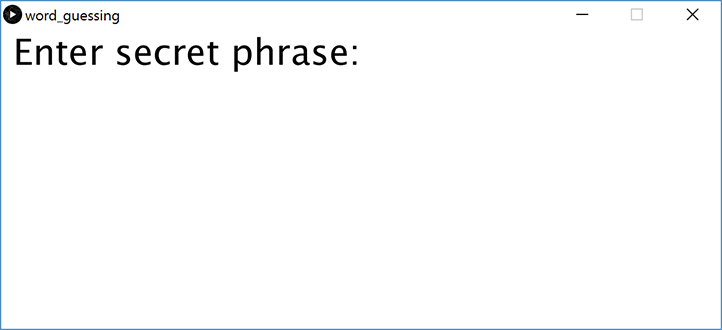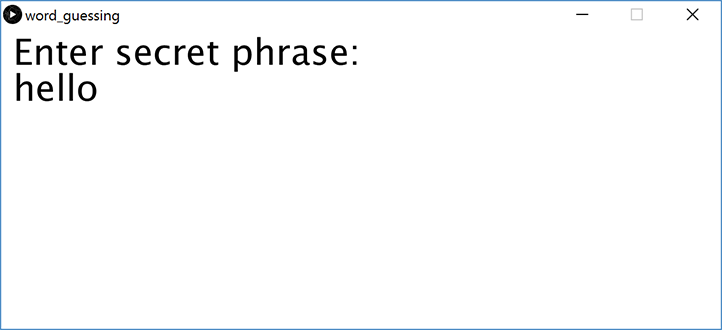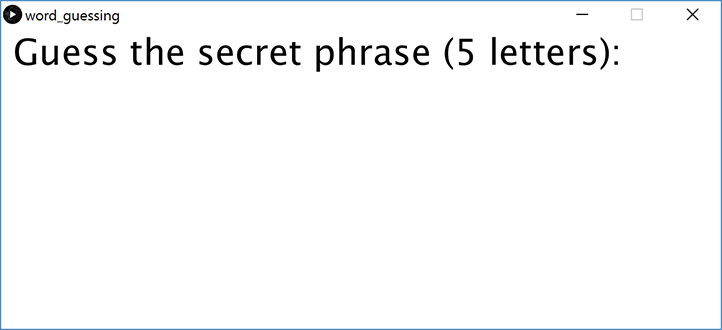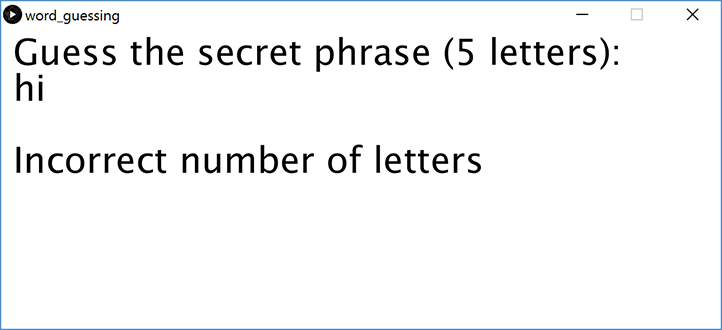Goals
- Learn how to work with text and Strings.
- Practice creating separate "stages" of a program.
Setup
Use this word_guessing.pde file as a starting point.
Word Guessing
We are going to create a program to play a word guessing game between two human players. The "mastermind" will provide a "secret phrase" and the player will guess what it is using feedback received from previous guesses.
We break this game down into three separate "stages" in a manner similar to the "pages" from the Jumping Monster assignment:
- The game asks the mastermind to enter the secret phrase. The keystrokes should be shown on the screen as the mastermind enters them. Once the mastermind presses [Enter], the secret phrase should be stored away and hidden on the screen.
- The game asks the player to guess the secret phrase. The length of the secret phrase should be shown. If the player guesses incorrectly, the game should give feedback as to how many letters of the guess were correct (correct letter and position).
- The player has correctly guessed the secret phrase. The secret phrase should be shown as well as the number of guesses it took the player. If the user presses any key in this stage, the game should reset.
The screenshots shown below are JUST A SUGGESTION! As usual, feel free to customize your program's appearance as desired.
Step 0: Working with Strings
String (note the upper-case 'S') is a datatype that consists of many characters put together.
For example, the string "hi!" is just the characters 'h', 'i', and '!' next to each other.
An example string variable declaration and initialization is:
String str = "I am a string";
The plus sign (+) is the concatenator operator and can be used to add a character or another string to the end of a string:
String str = "hello"; // str holds "hello" String tmp = ","; str = str + tmp; // str holds "hello," (added String var) str = str + ' '; // str holds "hello, " (added character) str = str + "world!"; // str holds "hello, world!" (added String literal)
To read an individual character from a String, we use the following charAt notation.
Note that this comes after a String variable name and a dot (.) and that the character positions are numbered from left-to-right starting at 0.
String str = "hello"; char c1 = str.charAt(0); // stores 'h' char c2 = str.charAt(4); // stores 'o'
Additionally, you can get the length of a string as follows:
String str = "hello";
int len = str.length(); // stores 5
Step 1: Reset
- Complete the function
reset()found at the bottom ofword_guessing.pde(code block 9).
This function should reset the game by setting variables to "default" values.
Which variables do we need to change and to what values will you set them?
Notice that this function is called at the end of setup().
Step 2: Test User Keyboard Input
- Complete the second
else ifblock of code inkeyPressed()(code block 7).
The condition has already been given to you and checks to make sure that the key pressed is one of the representable ASCII characters.
In this block of code, you should add the pressed key to the end of the variable guess.
To test to make sure that it is working, you should add a statement in draw() to display the current value of guess (either on your drawing canvas or on the console).
Now when you type, you should be able to see guess grow.
Note: The first else if block handles the [Backspace] and [Del] keys for you, so that the user can delete characters when mistakes are made.
We suggest that you try to understand how it works.
Step 3: Program Stage 0

- Complete the Stage 0 code block in
draw()(code block 1). - Complete the
stage == 0code block inkeyPressed()to handle the user pressing [Enter] while in Stage 0 (code block 4).
In Stage 0, the game should prompt the mastermind to enter the secret phrase.
One possible way to do this is shown in the image to the right.
Note: you should not use the variable message in Stage 0.
 As the mastermind types, the game should display the current value of
As the mastermind types, the game should display the current value of guess on the drawing canvas so the mastermind can see what has been typed so far.
This should be similar to the testing portion of Step 2 above.
What should happen once the mastermind presses [Enter]?
Write out the statements that correspond to this behavior in the stage == 0 conditional block within keyPressed().
Step 4: Program Stage 1

- Complete the Stage 1 code block in
draw()(code block 2). - Complete the
stage == 1code block inkeyPressed()to handle the user pressing [Enter] while in Stage 1 (code block 5).
In Stage 1, the game should prompt the player to guess the secret phase while displaying how many letters are in the phrase (see example image to the right).
As the player types, the game should display the current value of guess on the drawing canvas so the player can see what has been typed so far.
What should happen once the player presses [Enter]?
We only want to transition to Stage 2 if the guess was correct.
Here is a neat benefit of abstraction -- even though we haven't written the function guessing() yet, we can still design other parts of our program using it if was assume that it will work as described!
Your code block 5 should be written to include a call to guessing(), remembering that it returns a boolean value.
Step 5: Implement Guess Checking
- Complete the function
guessing()(code block 8).
Notice that its return type is a boolean.
If the variable guess matches the variable answer, then it should return true, otherwise it should return false.
 Despite being told how long the secret phrase is, sometimes the player will either miscount or purposely ignore this hint, so we want to do some input checking first.
If the length of
Despite being told how long the secret phrase is, sometimes the player will either miscount or purposely ignore this hint, so we want to do some input checking first.
If the length of guess doesn't match the length of answer, then you should display a message to the user using the variable message (in the image to the right, message = "Incorrect number of letters").
You may need to update your Stage 1 code in draw() to display message on your drawing canvas.
How to we compare two different strings?
Unfortunately, the equality operator (==) works differently on String so we can't use it (beyond the scope of the course; ask a TA if curious).
Instead, let's write a loop that will compare each character of guess against the same character position in answer (== will work with characters).
Use the local variable correct to track how many letters were correct.
 We know that the guess was correct if the value in
We know that the guess was correct if the value in correct is equal to the length of the secret phrase!
If the guess was not correct, then we should display an appropriate message telling the player so and how many letter were correct (see image on right).
If the guess was correct, then we should change to Stage 2.
You should only report the number of correct letters if the guess was the appropriate length. You should, however, count the total number of guesses including guesses of inappropriate lengths.
Step 6: Program Stage 2

- Complete the Stage 2 code block in
draw()(code block 3). - Complete the
stage == 2code block inkeyPressed()to handle the user pressing [Enter] while in Stage 2 (code block 6).
In Stage 2, the game should congratulate the player and display both the secret phrase and the number of guesses that it took (see image on right).
Finally, complete the keyPressed() function so that the game will reset if the user presses [Enter].
Submission
- Make sure that your name (and your partner's name) is included in your file.
- Make sure that most of your lines of code have comments so that someone else can understand it.
- Submit your finished
.pdefile from Step 6 to the Canvas assignments page.